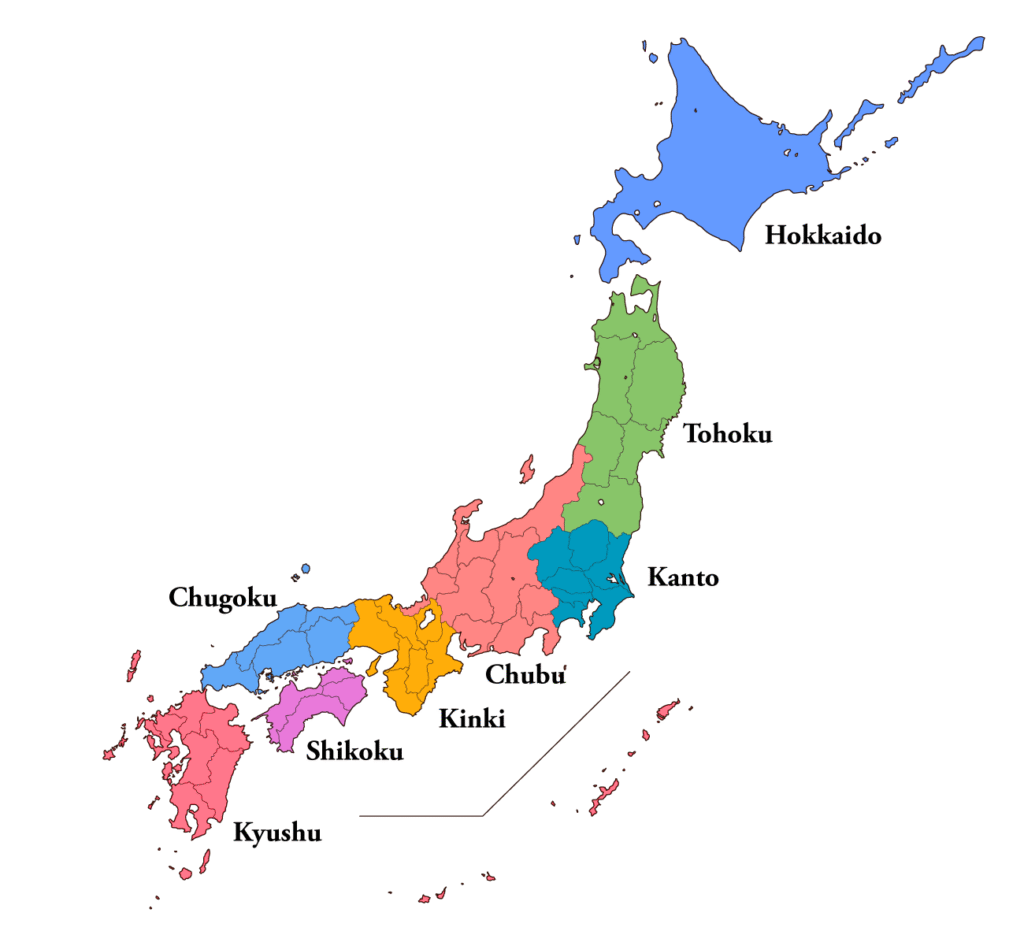Japan, with its elongated national land, diverse natural environment, and historical background, has various ways of being divided into regions. This article introduces “regional divisions of Japan” from multiple perspectives, including administrative units, culture, nature, climate, language, and even the distribution of animals.
- Administrative Divisions | Prefectures and Regional Blocks
- Divisions by Natural Features
- Divisions by Culture
- Divisions by Economic and Social Ties
- Divisions Used in Weather Forecasts
- Historical Regional Divisions
- Divisions by Animal Distribution
- Divisions by Language (Dialects)
- Divisions by Population Distribution
- Conclusion
Administrative Divisions | Prefectures and Regional Blocks
The basic administrative divisions of Japan are the “prefectures.”
- To (Metropolis): Tokyo (the capital)
- Do (Territory): Hokkaido
- Fu (Urban Prefectures): Osaka and Kyoto
- Ken (Prefectures): The other 43 regions
In total, Japan has 47 prefectures, each conducting its own local administration.
These are often grouped into eight larger regions as follows:
| Region | Main Prefectures |
|---|---|
| Hokkaido Region | Hokkaido |
| Tohoku Region | Aomori, Iwate, Miyagi, Akita, Yamagata, Fukushima |
| Kanto Region | Tokyo, Kanagawa, Saitama, Chiba, Ibaraki, Tochigi, Gunma |
| Chubu Region | Niigata, Toyama, Ishikawa, Fukui, Yamanashi, Nagano, Gifu, Shizuoka, Aichi |
| Kinki (Kansai) Region | Mie, Shiga, Kyoto, Osaka, Hyogo, Nara, Wakayama |
| Chugoku Region | Tottori, Shimane, Okayama, Hiroshima, Yamaguchi |
| Shikoku Region | Tokushima, Kagawa, Ehime, Kochi |
| Kyushu Region | Fukuoka, Saga, Nagasaki, Kumamoto, Oita, Miyazaki, Kagoshima, Okinawa |
Divisions by Natural Features
Based on natural environments, divisions can be drawn along mountain ranges, rivers, or climatic zones.
- Central Highlands and surrounding plains: Mountain ranges such as the Japanese Alps form a boundary between eastern and western culture.
- Sea of Japan side vs. Pacific Ocean side: Marked climatic differences, especially in winter snowfall.
- Temperate vs. Subtropical: Honshu and further north belong to the temperate zone, while Okinawa and the Nansei Islands belong to the subtropical zone.
Divisions by Culture
From a cultural standpoint, eastern and western Japan differ in food culture, festivals, and lifestyle practices.
- Flavor differences: Strong soy sauce flavor in Kanto, lighter broth-based flavor in western Japan.
- Festivals and rituals: The Nebuta Festival in Tohoku, the Gion Festival in western Japan.
- Marriage and funeral customs: Details of ceremonies also differ by region.
Divisions by Economic and Social Ties
Other divisions arise from economic and daily life connections.
- Greater Tokyo Area (capital region): Tokyo, Kanagawa, Saitama, Chiba
- Kinki Area (around Osaka): Osaka, Kyoto, Hyogo
- Chukyo Area (around Nagoya): Aichi, Gifu, Mie
These reflect commuting, schooling, and trade flows, showing real social linkages beyond administrative lines.
Divisions Used in Weather Forecasts
For practical weather reporting, the Japan Meteorological Agency uses its own divisions.
Terms such as “Kanto-Koshin,” “Tokai,” “Hokuriku,” and “Chugoku-Shikoku” are used, which do not perfectly match administrative divisions. For example, Nagano Prefecture is in the Chubu Region administratively but is often grouped into “Kanto-Koshin” for forecasts, since weather patterns are similar.
Historical Regional Divisions
Japan also has historically used regional divisions:
- “Gokishichido” system under the Ritsuryo codes: Administrative and military divisions in ancient Japan.
- Domains (Han) in the Edo period: Regions ruled by feudal lords.
- Prefectural system after the Meiji era: Basis of today’s prefectures.
These historical divisions still influence regional culture, dialects, and local character today.
Divisions by Animal Distribution
From a biological viewpoint, distribution of animals varies by region.
- Asiatic black bears live in Honshu north of central Japan.
- Mongooses are limited to Amami and Okinawa.
- Japanese macaques range widely from Aomori to Yakushima.
Such differences arise due to mountain ranges, temperature, precipitation, and isolated islands.
Divisions by Language (Dialects)
Japanese also has regional variations known as dialects.
- Tohoku dialect (e.g., zunda, ~dabe)
- Kansai dialect (e.g., ~yanen, honma)
- Kyushu dialect (e.g., ~tai, yoka)
Some dialects differ greatly in vocabulary and pronunciation from standard Japanese, making them hard for outsiders to understand. Dialects reflect local history and human connections, and they are valuable cultural heritage.
Divisions by Population Distribution
Japan’s population is unevenly distributed, with notable trends:
- About one-third of the population is concentrated in the Tokyo metropolitan area (Tokyo, Kanagawa, Saitama, Chiba).
- Outside major cities, depopulation and aging are progressing.
- Mountainous and remote islands have many depopulated areas.
Based on these trends, policy divisions such as “depopulated areas” and “urban regeneration priority areas” exist. Balancing urban and rural areas is a major issue.
Conclusion
There is no single “regional division of Japan.” Besides administrative units, there are many perspectives, including natural environment, culture, language, and economic zones. Understanding these allows a more multi-dimensional view of Japan’s diversity and depth.
Differences in speech, food, and scenery depending on the region are among Japan’s attractions. By recognizing regional differences, one can see a richer picture of Japan.



Comments